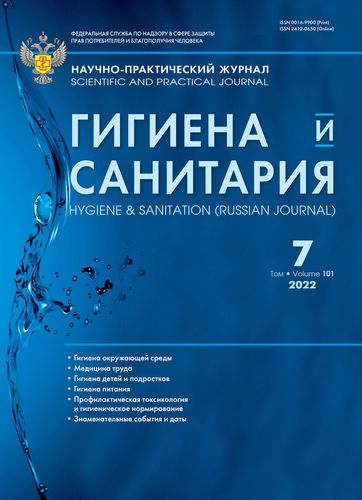Evaluation of the roadside soil of the P72 highway by the content of heavy metals and arsenic
- 作者: Martsev A.A.1, Selivanov O.G.1, Trifonova T.A.2
-
隶属关系:
- Vladimir State University named after Alexander and Nikolay Stoletovs
- Lomonosov Moscow State University
- 期: 卷 101, 编号 7 (2022)
- 页面: 730-735
- 栏目: ENVIRONMENTAL HYGIENE
- ##submission.datePublished##: 10.08.2022
- URL: https://archivog.com/0016-9900/article/view/639100
- DOI: https://doi.org/10.47470/0016-9900-2022-101-7-730-735
- ID: 639100
如何引用文章
全文:
详细
Introduction. The paper presents studies on the assessment of the level of pollution by motor vehicles of the soil of the roadside territory of the new section of the reconstructed highway.
Materials and methods. The object of the study was the soil of the roadside territory of the new section of the highway of regional significance “Vladimir-Murom-Arzamas” (P72). The registration number in the territory of the Vladimir region is 17P-1.
Results. It was found that with the launch of a new section of the reconstructed highway, the roadside area was found to be significantly contaminated with heavy metals and arsenic due to the impact of gas-air emissions of passing vehicles. Gas-air emissions of motor vehicles increase the content of technogenic magnetite particles in the soil, which increase the magnitude of the magnetic susceptibility of soils. Aggregation of heavy metals (НМ) by magnetite particles and their sorption contributes to the accumulation of hm in the soil of the roadside area. When moving away from the highway, the content of heavy metals and arsenic in the soil of the roadside area decreases. The indicator of accumulation of НM and arsenic in the soil of the roadside area increases in the series: Zn → Ni → As → Cu → Pb. By the end of the year of operation of the new section of the reconstructed highway, the excess of the MPC for lead and arsenic was revealed, and the content of Zn and Cu in the roadside soil is close to the values of the MPC.
Limitations. The limitations of the study are related to the remoteness of sampling points relative to the roadway and a small number of reference sites, which limits the possibilities of a broader interpretation of the data obtained.
Conclusion. To prevent the current dangerous trend, it is necessary to manage sanitary and hygienic monitoring of the soil of the roadside area exposed to constant exposure and accumulation of НM, in order to detect exceedances of the MPC and UEC and take measures to protect these territories.
Contribution:
Martsev A.A. — the concept and design of the study, collection and processing of material, writing a text;
Selivanov O.G. — laboratory research, data processing, text writing;
Trifonova T.A. — the concept and design of the study, text writing.
All authors are responsible for the integrity of all parts of the manuscript and approval of the manuscript final version.
Conflict of interest. The authors declare no conflict of interest.
Acknowledgement. The study had no sponsorship.
Received: November 11, 2021 / Accepted: June 08, 2022 / Published: July 31, 2022
作者简介
Anton Martsev
Vladimir State University named after Alexander and Nikolay Stoletovs
编辑信件的主要联系方式.
Email: martsevaa@yandex.ru
ORCID iD: 0000-0002-3572-9163
MD, PhD, lecturer of the department of biology and ecology, Vladimir State University named after Alexander and Nikolay Stoletovs, Vladimir, 600000, Russian Federation.
e-mail: MartsevAA@yandex.ru
俄罗斯联邦Oleg Selivanov
Vladimir State University named after Alexander and Nikolay Stoletovs
Email: noemail@neicon.ru
ORCID iD: 0000-0003-3674-0660
俄罗斯联邦
Tatyana Trifonova
Lomonosov Moscow State University
Email: noemail@neicon.ru
ORCID iD: 0000-0002-1628-9430
俄罗斯联邦
参考
- Trifonova T.A., Podolets A.A., Selivanov O.G., Martsev A.A., Podolets A.A. Assessment of soil contamination in the recreational areas of the city by the industrial compounds of heavy metals and arsenic. Teoreticheskaya i prikladnaya ekologiya. 2018; (2): 94–101. https://doi.org/10.25750/1995-4301-2018-2-094-101/1 (in Russian)
- Timofeeva Ya.O. The role of iron-manganese nodules in accumulation of heavy metals in the soils of areas adjacent to motorway. Izvestiya Irkutskogo gosudarstvennogo universiteta. Seriya: Biologiya. Ekologiya. 2013; 6(3): 94–9. (in Russian)
- Trifonova T.A., Martsev A.A. A assessment of the impact of air pollution on population morbidity rate in the Vladimir region. Gigiena i Sanitaria (Hygiene and Sanitation, Russian journal). 2015; 94(4): 14–8. (in Russian)
- Komarov V.I., Selivanov O.G., Martsev A.A., Podolets A.A., Lukyanov S.N. Heavy metals contamination in arable horizon of soils of agricultural appointment of the Vladimir region. Agrokhimiya. 2019; (12): 75–82. https://doi.org/10.1134/S0002188119100089 (in Russian)
- Trifonova T.A., Martsev A.A., Selivanov O.G. Gas-air emissions from glass container production as a risk factor for public health. Teoreticheskaya i prikladnaya ekologiya. 2020; (4): 155–61. https://doi.org/10.25750/1995-4301-2020-4-155-161 (in Russian)
- Kabata-Pendias A., Pendias H. Trace Elements in Soils and Plants. Boca-Raton-London-New-York-Washington: CRC Press; 2001.
- Vodyanitskiy Yu.N., Shoba S.A. Magnetic susceptibility as an indicator of heavy metal contamination of urban soils. Vestnik moskovskogo universiteta. Seriya 17. Pochvovedenie. 2015; (1): 13–20. (in Russian)
- Lu S.G., Bai S.Q., Fu L.X. Magnetic properties as indicator of Cu and Zn contamination in soils. Pedosphere. 2008; (18): 479–85. https://doi.org/10.1016/S1002-0160(08)60038-7
- Bućko M.S., Magiera T., Pesonen L., Janus B. Magnetic, geochemical, and microstructural characteristics of road dust on roadsides with different traffic volumes — case study from Finland. Water Air Soil Pollut. 2010; (09): 95–306. https://doi.org/10.1007/s11270-009-0198-2
- Bućko M.S., Magiera T., Johanson B., Petrovský E., Pesonen L.J. Identification of magnetic particles in road dust snow using magnetic, geochemical and micromorphological analyses. Environ. Pollut. 2011; (159): 1266–76. https://doi.org/10.1016/j.envpol.2011.01.030
- Vodyanitskiy Yu.N. Standards for the content of heavy metals and metalloids in soils. Pochvovedenie. 2012; (3): 368–75. (in Russian)
- Manceau A., Marcus M.A., Tamura N., Prous O., Geoffroy N., Lanson B. Natural speciation of Zn at the micrometer scale in a clay soil using X-ray fluorescence, absorption, and diffraction. Geocim. Cosmochim. Acta. 2004; (68): 2467–83. https://doi.org/10.1016/S0016-7037(03)00883-4
- Wang Q., Dong Y., Cui Y., Liu X. Instances of soil and crop heavy metals contamination in China. Soil Sediment. Contam. 2001; (10): 497–510. https://doi.org/10.1080/20015891109392
- Jordanova D., Goddu S.R., Kotsev T., Jordanova N. Industrial contamination of alluvial soils near mining site revealed by magnetic and geochemical studies. Geoderma. 2013; 192: 237–48.
补充文件







